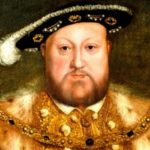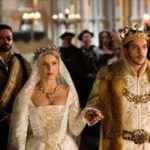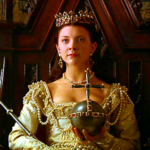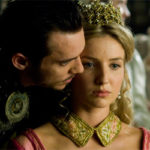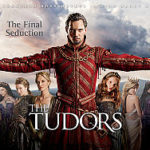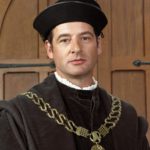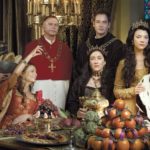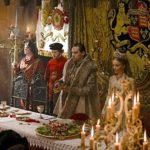It is a truth universally acknowledged that film and TV period drama plays havoc with historical accuracy in order to make the series as inviting to viewers as possible, and where possible by sexing up the content. This has been a running debate within my reviews, so a good starting point are a few essential rules for making biopics:
- In condensing all or part of a lifetime into the format of a 2-hour movie or a series of TV dramas, by definition truths must be amended or omitted.
- For dramatic effect, the sequence and timing of historical events is also routinely distorted.
- There must be elements of truth, though it’s fair to say that some, like Miles Ahead, include whole plot sections that are totally fictional.
- In the same way, characters are often combined, omitted or fictional characters added; some are made to say or do things they never said or did, and their relative importance is frequently changed to simplify life for viewers.
Inevitably, this process does not please all, particularly where truths and often unpalatable changes are made. Historians would say there is no excuse for fictionalising what is documented truth, if the series purports to be an accurate reflection of history. But do they claim that? Indeed, is that what the audience expects?
So this is less a review and more a summary of the debate about historical accuracy, with comments, as it pertains to the Showtime series The Tudors. I barely need to go into the litany of often deliberate errors within the show save for a few startling examples, but a good starting point is these quotes to set out the two sides of the debate. For those who delight in such information, see the list included by Wikipedia at the bottom of this blog.
Ding ding! Round 1:
As creator Michael Hirst noted, “Showtime commissioned me to write an entertainment, a soap opera, and not history … And we wanted people to watch it.” He added that some changes were made for production considerations and some to avoid viewer confusion, and that “any confusion created by the changes is outweighed by the interest the series may inspire in the period and its figures.”
By contrast, Tudor historian David Starkey was less than impressed:
One of the most vocal critics of the show has been historian David Starkey, who has described it as “gratuitously awful” and riddled with errors and inaccuracies. Dr Starkey, a specialist in the Tudor period, said previously that it was a disgrace the BBC had “squandered” public money on a historical drama which he claimed had been deliberately “dubbed down” to appeal to an American audience.
The final charge is undeniable. The series is not without its sophistications, but many viewers would let this and the historical bloopers wash over them in favour of the lush visuals: the lush sets and expensive costumes. In look, feel and watchability, it clearly won a regular audience in the States and here too, by sexing up and dumbing down. As Dr Tracy Borman, a rival Tudor expert put it:
“I was determined to loathe the series, with its unfeasibly beautiful actors, dodgy costumes and improbable storylines, but found myself becoming strangely addicted….Yes, the scriptwriters may have taken liberties with the facts, but they have also succeeded in re-creating the drama and atmosphere of Henry VIII’s court, with its intrigues, scandals and betrayals… (the show had) undoubtedly stimulated interest in British history.”
I wonder how many viewers actually took to historical research? Not many, I’ll be bound. Either way, Starkey will be fuming into his scotch that the story of the King’s reign should be turned into what was once called a “bodice ripper,” for of heaving bosoms and well-honed loins in the act of copulation there are many – not typically what would be portrayed in a straight history.
But back to the depiction of facts, all the more timely for the “alternative facts” scandal to explain outright lies. The counter from the Tudors‘ writer, with echoes of the Donald Rumsfeld “unknown unknowns” speech, runs thus:
Writer Hirst believes that The Tudors brings out into the open the gaps and contradictions in the historical record that academic history shies away from. “Of course, there are certain facts which are incontrovertible,” he says, “but beyond that there’s just interpretation and there are surprisingly few sources. So I discovered that the truth is variable and I also discovered that most historians are very bad psychologists: They don’t tell you very much about the human relationships in history. I’ve discovered that nearly all the caricatures of Henry’s wives for instance, are nonsense or only tell a little bit of the story.”
And Ben Stephenson, the BBC controller of drama commissioning, previously stated that period drama did not have to be strictly accurate:
“We take the feedback on board but, for me, the purpose of drama is to entertain, not to be slavish about detail. I think that absolute dedication to perfect detail is something for a documentary and not something for a drama.”
But then, the attention to detail in The Tudors has not been slavish to straight history. Indeed, a cursory glance at the websites devoted to the series will tell you that the costumes are more Elizabethan than of Henry’s era, and the use of carriages is Victorian rather than Tudor. That’s surely a perversely distorted image?
A critical difference of opinion concerns the svelte appearance of Jonathan Rhys Meyers, contrasting with the increasingly obese King Henry VIII, whose waist measurement apparently reached the epic proportions of 54 inches and well north of 20 stones before the time of his death.
Why then would the series eschew this basic fact about our own whizz-kid monarch? Simple: to retain Henry’s sex appeal for modern audiences. Fact is that in Tudor days appearance was less an issue for men, power was the aphrodisiac for women. So long as the monarch could do his duty and impregnate wives with male children, their corpulence was a minor consideration.
These days however, production companies certainly believe audiences expect their stars, certainly at the younger end of the age band, to be beautiful and svelte. Truth be told, the entire court to a man and simpering maiden is beautiful with nary an ounce of surplus fat to be seen. This includes those people who in real life were said to be anything but beautiful, including Catherine of Aragon and Anne of Cleves; even Jane Seymour, to whom Henry was apparently devoted, was not a looker, according to contemporary reports – but in the person of Annabel Wallis she is spectacular.
Ah, but it’s all in the symbolism, you see; as Dr Borman puts it:
‘…while Rhys Meyers bore “little resemblance to the red-headed, bloated image people have of the King Henry… he does at least evoke the dangerously seductive charisma and magisterial arrogance that kept a court in thrall for almost 40 years”.’
So the question is really whether the mood of Henry’s court has been captured, mixing as it does political, religious and sexual intrigue in close harmony. Everywhere you look malevolent scheming is afoot, albeit in dialogue imagined rather than actually spoken and, unsurprisingly, cast in rather more modern language than would have been spoken in the Tudor era – one piece of ‘dumbing down’ even historians would agree is vital.
In the first season, most of the conniving comes from Sam Neill‘s deliciously evil and self-serving Cardinal Wolsey, at least up to the point where he is rumbled and drummed out of the role of Lord Chancellor. Wolsey deftly juggles his own interests, the papacy, ambassadors of the French and Holy Roman Empire in a bid to balance Henry’s desire to have his marriage to the devout Catherine of Aragon annulled without wrecking relations with the Vatican or with the other major powers, allowing him to marry the woman viewed as a slut and commoner, Anne Boleyn.
However, even Wolsey cannot escape the myriad of inaccurate detail, since he is maliciously portrayed as having cut his own throat when in fact he died in transit of an unspecified illness. Was that really necessary? It’s not as if the series stinted on official executions after Wolsey’s demise, what with the principled Sir Thomas More and the unflinching Cardinal Fisher meeting a bloody end, both for daring to oppose the principle of the Reformation, namely that the King was head of the Church in England.
Fair to say that the handling of religious affairs is probably closer to the history book than other aspects, maybe for fear of offending the religious viewer. Not that Henry nor the Catholic Church come out of the series smelling of roses – all the more so since the magnificent Peter O’Toole steps into series 2 as Pope Paul III (albeit minus beard.) Whatever the virtues of the script, O’Toole’s magnetic charisma is undeniable.
But I digress. The fact is that the series knowingly and unapologetically takes liberties with history, as does pretty much every other such drama, with far more leeway than mere “interpretation” would allow. Just for once it would be interesting to see a series made strictly according to proven and documented historical fact, and whether it suffers dramatically as a result of a lack of compromise.
One would hope some governance would be applied, though one suspects that the production companies care far more about viewing figures and lose not one moment of sleep for having rewritten history.
One last thought to leave you with: even history is not necessarily reliable, least of all Tudor history, as discussed by Dr Lucy Worsley in her latest series. From the BBC blurb:
Lucy debunks the foundation myth of one of our favourite royal dynasties, the Tudors. According to the history books, after 30 years of bloody battles between the white-rosed Yorkists and the red-rosed Lancastrians, Henry Tudor rid us of civil war and the evil king Richard III. But Lucy reveals how the Tudors invented the story of the ‘Wars of the Roses’ after they came to power to justify their rule.
She shows how Henry and his historians fabricated the scale of the conflict, forged Richard’s monstrous persona and even conjured up the image of competing roses. When our greatest storyteller William Shakespeare got in on the act and added his own spin, Tudor fiction was cemented as historical fact.
Taking the story right up to date, with the discovery of Richard III’s bones in a Leicester car park, Lucy discovers how 15th-century fibs remain as compelling as they were over 500 years ago. As one colleague tells Lucy: ‘Never believe an historian!
Under these circumstances, even the eminent Dr Starkey cannot be guaranteed to have every aspect of Henry’s history spot on. Maybe there is room for licence and embroidery?
Departures from history
Many events in the series differ from events as they actually happened in history. Liberties are taken with character names, relationships, historical costume, physical appearance and the timing of events.[1] As creator Hirst said, “Showtime commissioned me to write an entertainment, a soap opera, and not history … And we wanted people to watch it.”[2] He added that some changes were made for production considerations and some to avoid viewer confusion, and that “any confusion created by the changes is outweighed by the interest the series may inspire in the period and its figures.”[2]
- Time is compressed in the series, giving the impression that things happened closer together than they actually did or along a different timeline. By the time of most of the events in this series, King Henry VIII was already in his mid-to-late 30s. In reality, Catherine of Aragon was only six years his elder, and he was approximately a decade older than Anne Boleyn. Maria Doyle Kennedy is thirteen years older than Jonathan Rhys Meyers, who is, in turn, only five years Natalie Dormer‘s elder.[2] Also, Anne was recalled to Henry’s court from France three years after her sister Mary Boleyn, not simultaneously, and Henry did not begin to court her until 1526. The matter of Henry falling enough in love with Anne to seek an annulment, ultimately severing from the Catholic Church, setting aside Catherine and marrying Anne took another seven years to resolve, culminating in Anne’s coronation in 1533. In the series, the timeline from introduction to marriage seems to take little more than a year. The assassination attempt on Anne during her coronation procession was a completely fictional event, invented by Hirst “to illustrate how much the English people hated her”.[2]
- Historically, Cardinal Wolsey died of an unspecified illness in Leicester in 1530, while en route to London to answer charges of treason. In the series, it is implied that this report of illness is part of a cover-up by Henry and Thomas Cromwell, to prevent anyone from knowing that the cardinal had committed suicide.[2]
- In the show, the Duke of Norfolk does not appear after Season One, implied to have been retired. In reality, he played important roles in both the purge of the Boleyns and the suppression of the Pilgrimage of Grace, deeds fulfilled by Charles Brandon in the show.
- The character of Henry’s sister, called “Princess Margaret” in the series, is actually a composite of his two sisters: the life events of his younger sister, Princess Mary Tudor, coupled with the name of his elder sister, Margaret Tudor. This was reportedly done to avoid confusion with Henry’s daughter, Mary I of England.[2][15]
- Historically, Henry’s younger sister Princess Mary first married the French King Louis XII. The union lasted approximately three months, until his death; Louis was succeeded by his cousin Francis I, who was married to Louis’s daughter, Claude of France. Mary subsequently married Charles Brandon, 1st Duke of Suffolk, and had four children with him; their eldest daughter, Frances, was the mother of Lady Jane Grey, who held the English throne for nine days between the death of Henry’s son Edward and the ascension of Henry’s eldest daughter Mary. Mary Tudor died of unknown causes in 1533, not long after Henry’s marriage to Anne Boleyn. Henry’s eldest sister, Margaret Tudor, was in fact married to King James IV of Scotland, was grandmother of Mary, Queen of Scots and died of a stroke in 1541.
- Early in the series Henry VIII is also styled as King of Ireland, a title he in real life did not use until his break with Rome. Until that point he was only Lord of Ireland.
- In the second episode, Cardinal Wolsey is passed over for the papacy in favor of Cardinal Orsini following the death of Pope Alexander (presumably referring to Pope Alexander VI). In fact, Pope Alexander VI died in 1503, six years before Henry VIII’s ascension to the throne, and was succeeded by Cardinal Piccolomini, who became Pope Pius III. The series later refers to this same character as Pope Clement, presumably making this Pope Clement VII. It thus appears the fictional Cardinal Orsini papacy combines that of five actual popes during this time: Pope Pius III, Pope Julius II, Pope Leo X, Pope Adrian VI, and Pope Clement VII. Interestingly, none of these real popes was known as “Cardinal Orsini” prior to election as pope.
- As The Tudors begins, Louis XII has already died, and Henry is already negotiating a peace treaty with Francis. The series’s Princess Margaret thus marries a fictional, elderly Portuguese king (possibly based on Manuel I of Portugal), who lives only a few days until she smothers him in his sleep.[2][16] She then marries Brandon against Henry’s wishes, and the pair have only one child, a son, before the fictional Margaret dies of consumption. Her death scenes are juxtaposed with Wolsey’s, implying that they died at the same time. The fictional Brandon goes on to marry again, but has no further issue. This composite character and her life-story arc technically eliminate the children that led to Mary, Queen of Scots (although James V is correctly referenced in the show as both Henry VIII’s nephew and Mary’s son) and Lady Jane Grey, both of whom played important roles in future monarchical politics for Henry’s daughters. Neither of the sons of Mary Tudor and Charles Brandon lived to adulthood: one died at age six and the other at age eleven.
- The series also portrays Margaret as Charles Brandon’s first wife, and implies that he married Catherine Willoughby to be a mother to his and Margaret’s young son, and that he had no other children before or after the child he had with Margaret. In reality, Mary Tudor was Charles’s third wife and Catherine his fourth. In addition to the four children he had with Margaret, he also had two by his second wife, Anne Browne (who was the niece of his first wife), and two by Catherine. He also had three illegitimate children.
- The king’s illegitimate son Henry Fitzroy was shown to be born near the beginning of the series and dying at a young age from the sweating sickness. In fact, he lived until 1536, long enough to marry the only daughter of Anne Boleyn’s uncle Thomas Howard, Duke of Norfolk, and be a witness to Anne Boleyn’s execution.
- Charles V, Holy Roman Emperor, whose parents were rulers of Castille, is given a Spanish accent when dealing with the king of England (S1E3), when in fact he was Flemish-born (though he never mastered Flemish) and French-educated; he did not learn Spanish until 1518.[citation needed]
- Likewise, in the show, Eustace Chapuys, the imperial ambassador to Henry’s court, has a Spanish accent, although the historical Chapuys was a native of Savoy, and his mother language was French. This is, presumably, also an attempt not to confuse the viewers.
- Sir Thomas More is seen ordering the death of Simon Fish by burning at the stake. However, Simon Fish, while arrested for heresy, died in prison of bubonic plague. His widow married James Bainham, another outspoken religious reformer, who was ultimately burned at the stake by Thomas More, according to John Foxe‘s Book of Martyrs. Peter Berglar, a German historian and author of A Lonely Voice against the Power of the State (Die stunde des Thomas Morus. Einer gegen die Macht)), explains that the heretics burnt at the stake occurred after he had lost all power. These were carried on instead by John Stokesley, Bishop of London, who was very active in persecuting heretics.
- The Countess of Salisbury (Princess Mary’s governess) was executed during Catherine Howard‘s time as Queen-consort. In the series, however, she and her son, Lord Montagu are executed before Henry meets Anne of Cleves.
- The court of Cleves shows not the coat of arms of the United Duchies of Jülich-Cleves-Berg but of the Kingdom of Prussia of the 18th century.
- At the welcoming reception for Anne of Cleves, Henry introduces his daughters as “Princess.” As both Mary and Elizabeth were still considered by Henry to be illegitimate, he would never have accorded them such a title, as it would in effect be declaring them legitimate. Neither Mary nor Elizabeth ever regained the title of Princess, and continued to be known as “Lady” until they each in turn succeeded to the throne.
- After the annulment of his marriage with Anne of Cleves, it was only rumored that they had an affair: there is no evidence of this and it seems likely that Anne remained a virgin until her death. Anne is portrayed as being extremely popular, with just about everyone preferring her to Catherine Howard. Although it is true that both Mary and Elizabeth remained close to Anne and seem to have preferred her company to Catherine’s, Anne was a rather neutral figure who inspired no great affection from either courtiers or commoners.
- Catherine Howard was referred to as a “distant relation” of the 3rd Duke of Norfolk in the series. In reality, he was her uncle, just as he was to Anne Boleyn, who was Catherine’s first cousin; Norfolk helped orchestrate both marriages. Contrary to the series’ portrayal of the household of the Dowager Duchess of Norfolk as a shelter for distantly related “aristocratic bastards”, and the resulting implication that Catherine Howard was an illegitimate child, in real life the Dowager Duchess was Catherine’s step-grandmother, wife of Catherine’s deceased grandfather the 2nd Duke of Norfolk, and Catherine was born to one of the 2nd Duke’s many sons in lawful wedlock – she was sent to live in the household because her father was impoverished and recently widowed. Norfolk is also barely mentioned with regards to Henry Howard, Earl of Surrey, being called a mere kinsman to him, when in actuality Surrey was the Duke’s eldest son and heir.
- By the time he married Catherine Howard, the real Henry was middle-aged (49) and obese, not a svelte, still relatively healthy man as portrayed on the show. This is perhaps quite relevant to appreciating historical context since Catherine’s affair with Sir Thomas Culpeper and her declaration of true love to him on the block would sit better with a 17-year-old girl trapped in a marriage to a much older and obese king.
- A few liberties are taken with Catherine Parr as well. Parr is portrayed as meeting Henry while her husband, Lord Latimer, is still alive and she was a casual acquaintance of Mary’s. In fact, she came to court only after his death, using her status as Catherine of Aragon’s goddaughter to secure a place in Mary’s household. Further, Mary is shown to be openly hostile towards Catherine Parr after discovering her Protestant views. In fact, Mary got on rather well with Parr and did not fall out with Catherine until after Henry’s death. Even then, her hostility had little to do with religion: she was angered when the dowager Queen married Thomas Seymour so soon after Henry’s death.
- In the series, Thomas Cranmer stops appearing after Anne’s downfall (implying that he lost favor due to his Boleyn connections), and that Bishop Gardiner was the one to interrogate Catherine Howard at Syon Abbey after her sexual indiscretions and adulteries were exposed. In reality, Cranmer was the one to interrogate the young queen, and although his popularity with the Crown might have fluctuated, he remained an influential member of Henry’s court and the Church of England until the ascension of Mary I in 1553. In the show, Henry does however put Edward Seymour in charge of the government after Henry’s death alongside Cranmer.
- Also, in season 4 during the execution of Lady Rochford and Catherine Howard, it is depicted in the series that Rochford was beheaded first. In fact this was the other way round and although Rochford appears to weep on the block, many accounts have praised both her and Catherine for their alleged bravery in the face of death. Though Rochford had suffered a nervous breakdown during her pre-execution imprisonment, the series exaggerates her mental instability just prior to her death. In reality, one eyewitness, a merchant named Ottwell Johnson, wrote that both Lady Rochford’s and Catherine Howard’s souls must be with God, for they made the most godly and Christian end.
- In the series, many characters were introduced only when they would produce the most drama or when they became prominent in the story arc for some reason. In reality, Jane Seymour is believed to have become a lady-in-waiting to Catherine of Aragon around 1527; Anne Boleyn had been serving Catherine in the same capacity for five years at that point, which means they were at court at the same time. Maud Green, Catherine Parr’s mother, was also an attendant of Catherine of Aragon’s, and Catherine of Aragon was Catherine Parr’s godmother. Anne Herbert (Catherine Parr’s youngest sister who is featured only in the last season of the series), was lady-in-waiting to all six of Henry’s wives. Catherine Howard was lady-in-waiting to Anne of Cleves, and Henry’s pursuit of her began during that time, rather than after the end of his fourth marriage as is shown in the series. Sir Frances Bryan, featured in the series only during Season 3, was actually a second cousin to both Anne Boleyn and Jane Seymour, and he became a member of Henry’s Privy chamber sometime between the king’s ascension and 1519. He was instrumental in the machinations behind Anne’s downfall, earning him the sobriquet: ‘The Vicar of Hell’. Also, the Earl of Surrey was present in the court during the tenure of his first cousin, Anne Boleyn, though the series portrays him as coming back to England around the time Jane Seymour became Queen.
- The incident of rape/murder which marks the introduction of Sir Thomas Culpeper in the series was a real event, but it took place in 1539, a full year before Catherine Howard’s marriage to Henry and nearly two prior to the beginnings of their affair. In reality, Culpeper was a favorite of Henry’s at court and a knight of the realm, having served as a courtier for other nobility as early as 1535. He was a member of Henry’s Privy chamber by 1540, when he was a member of the envoy that greeted Anne of Cleves when she arrived in England to marry Henry.
- Catherine Parr was only four years older than Mary I, and Mary was seventeen when her younger sister Elizabeth was born. The series portrays Mary as much younger: barely an adolescent at the time of Elizabeth’s birth and at least a decade younger than Catherine Parr. Also, Catherine Parr was a member of Mary’s household at the time of Lord Latimer’s death. Elizabeth, on the other hand, is depicted as being much older, with the series portraying her as a teenager when Henry married Catherine Howard. Historically, she was six years old at the time. Although Laoise Murray does indeed bear resemblance to the historical Elizabeth, being pale-skinned and copper-haired, she looks nothing like the dark-haired Jonathan Rhys-Meyers (Henry VIII); historically, Elizabeth was the spitting image of her father, although she had her mother’s eyes.
- In the second episode of the first season, Thomas Boleyn holds a Harris’s hawk (Parabuteo unicinctus) while addressing his daughter. In episode ten of the second season, Henry overlooks a pond with two trumpeter swans (Cygnus buccinator). These are American birds, which at the time would not have been present in English collections. In the sixth episode of the fourth season, ‘Stargazer’ lilies (Lilium ‘Stargazer’) are featured in the scene with Henry and Catherine Parr playing cards. ‘Stargazer’ lilies did not exist until 1974.
- Anne Askew was never given the mercy of a quick death through a sack of gunpowder tied to her neck. Witnesses say it took up to 15 minutes for her to die. Other details are accurate as her joints had been dislocated on the rack, by the torturers depicted in the episode, and she had to be brought to her execution, tied to a chair, removed in considerable agony to be tied to a seat on the stake.
- Anyone who looks closely discovers how the sun rises behind Stockholm City Hall 37 seconds into the opening credits of the series. This is in addition to a geographical deviation also an anachronism: City Hall was completed in 1923, 376 years after Henry VIII’s death. The National Romantic style is also a deviation.


